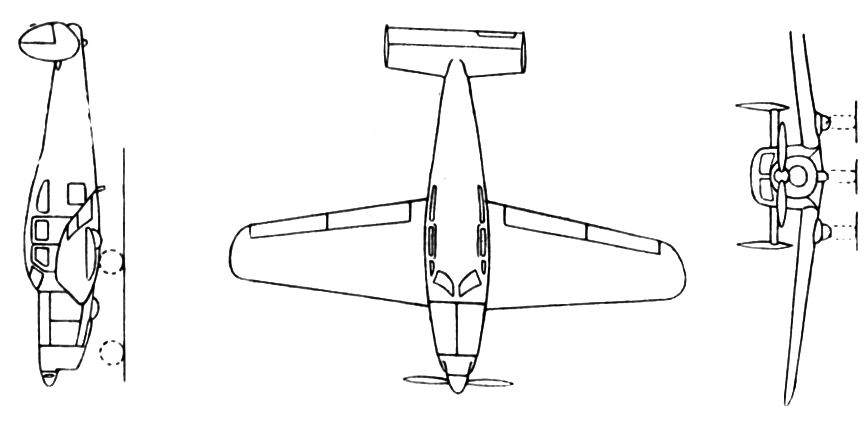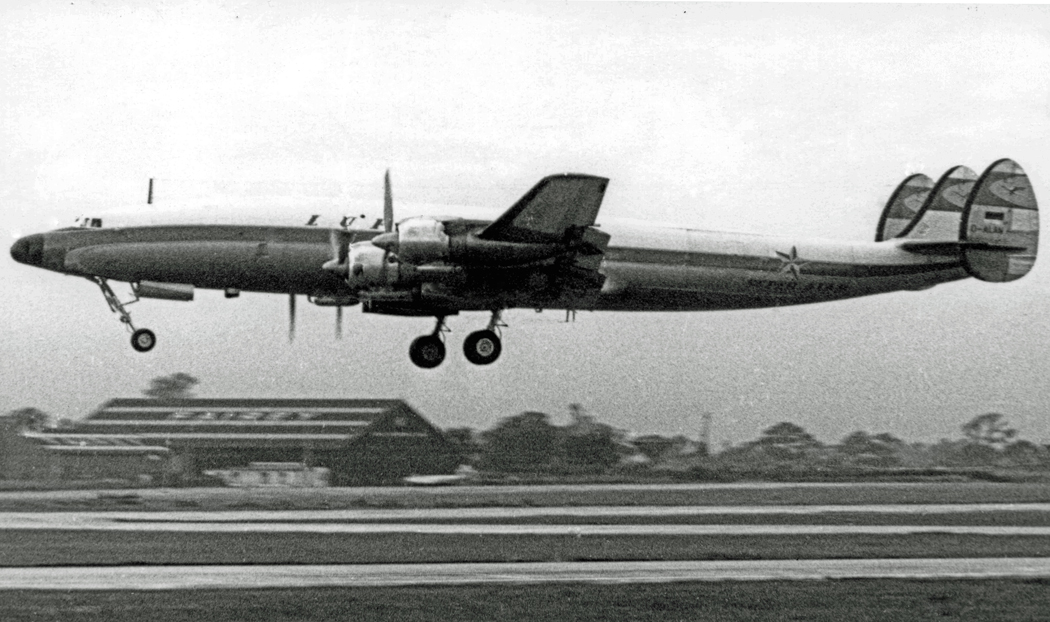|
Vega Model 2 Starliner
The Vega Model 2 Starliner was a prototype five-seat feeder airliner produced by the Vega Airplane Company, a subsidiary of Lockheed. It was designed to be powered by an unusual powerplant, consisting of two Menasco piston engines coupled together to drive a single propeller. A single example was built, flying in 1939, but no production followed. Design and development In 1935 Lockheed chief engineer Hall Hibbard discussed with Al Menasco the coupling of two Menasco C6S-4 engines mounted side-by side, driving a single propeller. In 1937, a Lockheed subsidiary, the AiRover Company, designed the Model 2 Starliner, to be powered by the new Menasco U2-544 Unitwin engine. The Starliner was a low-wing monoplane constructed with a light-alloy semi-monocoque structure conventional tail and rearward retracting undercarriage which remained exposed when retracted. The enclosed cabin was available in two cabin layouts: a custom luxury setup for private owners or a "Starliner" five seat ... [...More Info...] [...Related Items...] OR: [Wikipedia] [Google] [Baidu] |
WikiProject Aircraft
A WikiProject, or Wikiproject, is a Wikimedia movement affinity group for contributors with shared goals. WikiProjects are prevalent within the largest wiki, Wikipedia, and exist to varying degrees within Wikimedia project, sister projects such as Wiktionary, Wikiquote, Wikidata, and Wikisource. They also exist in different languages, and translation of articles is a form of their collaboration. During the COVID-19 pandemic, CBS News noted the role of Wikipedia's WikiProject Medicine in maintaining the accuracy of articles related to the disease. Another WikiProject that has drawn attention is WikiProject Women Scientists, which was profiled by ''Smithsonian Magazine, Smithsonian'' for its efforts to improve coverage of women scientists which the profile noted had "helped increase the number of female scientists on Wikipedia from around 1,600 to over 5,000". On Wikipedia Some Wikipedia WikiProjects are substantial enough to engage in cooperative activities with outside organization ... [...More Info...] [...Related Items...] OR: [Wikipedia] [Google] [Baidu] |
Mid-Continent Airlines
Mid-Continent Airlines was an airline which operated in the central United States from the 1930s until 1952 when it was acquired by and merged with Braniff International Airways. Mid-Continent Airlines was originally founded as a flight school at Rickenbacker Airport in Sioux City, Iowa, during 1928, by Arthur Hanford Jr., a dairy operator. The Hanford Produce Company was the largest creamery in the United States with over 100 trucks in operation. The company was primarily a dairy but also sold ice cream and poultry. The Hanford's also founded and built the new Rickenbacker Airport and operated eight gas stations and several service repair garages under the name Hanford's, Inc. The airport was a division of Hanford's, Inc., but the service stations and garages were later sold to finance airline operations. Mid-Continent was based in Kansas City, Missouri at the time of its acquisition by Braniff.http://www.timetableimages.com, Sept. 1, 1951 Mid-Continent Airlines system timetable ... [...More Info...] [...Related Items...] OR: [Wikipedia] [Google] [Baidu] |
1930s United States Civil Utility Aircraft
Year 193 ( CXCIII) was a common year starting on Monday (link will display the full calendar) of the Julian calendar. At the time, it was known as the Year of the Consulship of Sosius and Ericius (or, less frequently, year 946 ''Ab urbe condita''). The denomination 193 for this year has been used since the early medieval period, when the Anno Domini calendar era became the prevalent method in Europe for naming years. Events By place Roman Empire * January 1 – Year of the Five Emperors: The Roman Senate chooses Publius Helvius Pertinax, against his will, to succeed the late Commodus as Emperor. Pertinax is forced to reorganize the handling of finances, which were wrecked under Commodus, to reestablish discipline in the Roman army, and to suspend the food programs established by Trajan, provoking the ire of the Praetorian Guard. * March 28 – Pertinax is assassinated by members of the Praetorian Guard, who storm the imperial palace. The Empire is auctioned ... [...More Info...] [...Related Items...] OR: [Wikipedia] [Google] [Baidu] |
SNCASO SO
SNCASO (abbreviated from ''Société nationale des constructions aéronautiques du Sud-Ouest'', or commonly, ''Sud-Ouest'') was a French aircraft manufacturer. Created during 1936 as one of seven nationalised aeronautical manufacturing companies, SNCASO became a key French aircraft manufacturer following the end of the Second World War. It produced numerous innovation aircraft; amongst the company's more notable projects was the first French jet aircraft, the Sud-Ouest Triton, and the first indigenously-developed French helicopter, the Sud-Ouest Djinn. On 1 March 1957, SNCASO merged with another French nationalised aviation company, SNCASE, (''Société nationale des constructions aéronautiques du Sud-Est''), to form Sud Aviation. History Following the resolution of the 1936 general strike of French heavy industry, the government of Léon Blum introduced an act to nationalize the French war industry. The act provided for the creation of seven nationalised aeronautical manufa ... [...More Info...] [...Related Items...] OR: [Wikipedia] [Google] [Baidu] |
ERCO Ercoupe
The ERCO Ercoupe is an American low-wing monoplane aircraft that was first flown in 1937. It was originally manufactured by the Engineering and Research Corporation (ERCO) shortly before World War II; several other manufacturers continued its production after the war. The final model, the Mooney M-10, first flew in 1968 and the last model year was 1970. It was designed to be the safest fixed-wing aircraft that aerospace engineering could provide at the time, and the type continues to enjoy a faithful following. Design and development Fred Weick In 1931, aeronautical engineer Fred Weick was assistant chief of the aeronautics division of the National Advisory Committee for Aeronautics (NACA). In 1934 he asked permission to build an aircraft based on the 1931 Stout Skycar, using fabric instead of aluminum covering, and control modifications based on NACA research. Weick and a group of co-workers designed and assembled the experimental aircraft with a group of his colleagues ... [...More Info...] [...Related Items...] OR: [Wikipedia] [Google] [Baidu] |
Beechcraft Model 34
The Beechcraft Model 34 "Twin-Quad" was a prototype airliner designed and built by Beechcraft in the period between World War II and the Korean War.Phillips 1992 At this time many aircraft manufacturers in the United States anticipated a boom in civil aviation and a large number of designs left the drawing board only to ultimately fail. The Model 34 was one of these failures, partly because of its unusual design, and partly because of the thousands of ex-military transport aircraft that were available at the time for a fraction of the price of a new aircraft. Design and development The design was a four-engine high-wing monoplane with tricycle undercarriage, originally designed for 14 (three abreast seating with six additional seats mounted on the side) and eventually converted to take 20 passengers. The side "couch seats" were also able to be folded away so that cargo could be carried internally in the cabin. Individual storage space was provided for each passenger seat on the ... [...More Info...] [...Related Items...] OR: [Wikipedia] [Google] [Baidu] |
Menasco Unitwin 2-544
The Menasco Unitwin 2-544 was a coupled piston engine. Menasco Motors Company of Burbank, California was a well known manufacturer of inverted inline four and six cylinder engines. At the request of Lockheed Aircraft designers, Menasco produced an inverted twelve-cylinder air cooled aircraft engine by designing a common crankcase and gearbox for two of the six cylinder engines. The two crankshafts were combined with a unique double clutch gearbox to power a single propeller. This gave reliability of a twin engine aircraft in a single powerplant. It was a success, but did not enter production as no aircraft were produced that used it. Design and development In mid-1935 Lockheed's chief engineer, Hall Hibbard, began discussing with Al Menasco, the president of the Menasco Motors Company in Burbank, the merits of coupling two Menasco C6S Super Buccaneer six-cylinder in-line engines mounted side-by-side, driving a single propeller. In 1937 Lockheed established the AiRover Aircr ... [...More Info...] [...Related Items...] OR: [Wikipedia] [Google] [Baidu] |
Vega Starliner 3-view L'Aerophile May 1939
Vega is the brightest star in the northern constellation of Lyra. It has the Bayer designation α Lyrae, which is Latinised to Alpha Lyrae and abbreviated Alpha Lyr or α Lyr. This star is relatively close at only from the Sun, and one of the most luminous stars in the Sun's neighborhood. It is the fifth-brightest star in the night sky, and the second-brightest star in the northern celestial hemisphere, after Arcturus. Vega has been extensively studied by astronomers, leading it to be termed "arguably the next most important star in the sky after the Sun". Vega was the northern pole star around 12,000 BCE and will be so again around the year 13,727, when its declination will be . Vega was the first star other than the Sun to have its image and spectrum photographed. It was one of the first stars whose distance was estimated through parallax measurements. Vega has functioned as the baseline for calibrating the photometric brightness scale and was one of the st ... [...More Info...] [...Related Items...] OR: [Wikipedia] [Google] [Baidu] |
Burbank, California
Burbank is a city in the southeastern end of the San Fernando Valley in Los Angeles County, California, United States. Located northwest of downtown Los Angeles, Burbank has a population of 107,337. The city was named after David Burbank, who established a sheep ranch there in 1867. Billed as the "Media Capital of the World" and only a few miles northeast of Hollywood, numerous media and entertainment companies are headquartered or have significant production facilities in Burbank, including Warner Bros. Entertainment, The Walt Disney Company, Nickelodeon Animation Studio, The Burbank Studios, Cartoon Network Studios with the West Coast branch of Cartoon Network, and Insomniac Games. The broadcast network The CW is also headquartered in Burbank. The Hollywood Burbank Airport was the location of Lockheed's Skunk Works, which produced some of the most secret and technologically advanced airplanes, including the U-2 spy planes that uncovered Soviet Union missile components in Cu ... [...More Info...] [...Related Items...] OR: [Wikipedia] [Google] [Baidu] |
WikiProject Aircraft/page Content
A WikiProject, or Wikiproject, is a Wikimedia movement affinity group for contributors with shared goals. WikiProjects are prevalent within the largest wiki, Wikipedia, and exist to varying degrees within sister projects such as Wiktionary, Wikiquote, Wikidata, and Wikisource. They also exist in different languages, and translation of articles is a form of their collaboration. During the COVID-19 pandemic, CBS News noted the role of Wikipedia's WikiProject Medicine in maintaining the accuracy of articles related to the disease. Another WikiProject that has drawn attention is WikiProject Women Scientists, which was profiled by '' Smithsonian'' for its efforts to improve coverage of women scientists which the profile noted had "helped increase the number of female scientists on Wikipedia from around 1,600 to over 5,000". On Wikipedia Some Wikipedia WikiProjects are substantial enough to engage in cooperative activities with outside organizations relevant to the field at issue. Fo ... [...More Info...] [...Related Items...] OR: [Wikipedia] [Google] [Baidu] |
Lockheed L-1649 Starliner
The Lockheed L-1649 Starliner was the last model of the Lockheed Constellation line of airliners. Powered by four Wright R-3350 TurboCompound engines, it was built at Lockheed's Burbank, California plant from 1956 to 1958. Design and development Development of the Starliner began when Lockheed designed the L-1449 in response to the Douglas DC-7C Seven Seas.Breffort, Dominique. Lockheed Constellation: from Excalibur to Starliner Civilian and Military Variants. Histoire and Collecions, 2006. p.112 to 117 Powered by four 5500 hp Pratt & Whitney PT2G-3 turboprop engines, the L-1449 would have cruised faster than the DC-7C with comparable range with of fuel in a new wing. Pratt & Whitney dropped the PT2 project in March 1955 due to expected unreliability, high specific fuel consumption and high operating costs, though the T34 military version of the engine powered the Douglas C-133 freighter, which was also plagued with unreliability. The L-1449 would have been about l ... [...More Info...] [...Related Items...] OR: [Wikipedia] [Google] [Baidu] |






